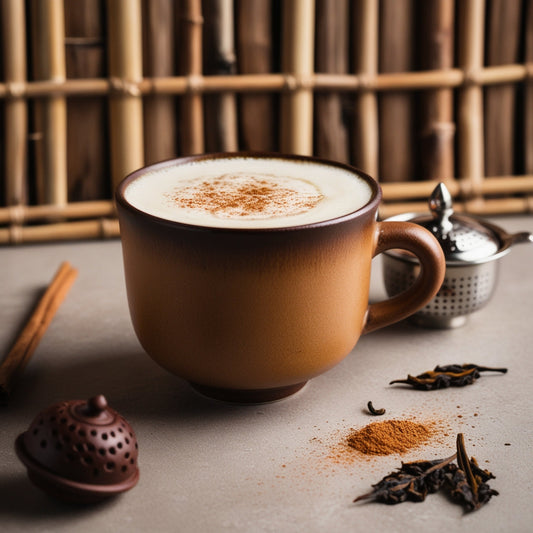Introduction
Tea that's not just a beverage but a centuries-old tradition steeped in rich flavours and cultural significance? Let us introduce you to Pu-erh tea, an extraordinary fermented tea from China's Yunnan province that has captivated tea enthusiasts. Made from the unique Yunnan big leaf variety of the Camellia sinensis plant, Pu-erh tea stands out due to its fascinating fermentation process. Whether you're a seasoned tea connoisseur or a curious newcomer, diving into the distinct characteristics of Ripe Pu-erh tea like health benefits, how it tastes and correct way to brew.
Table of Content
- Introduction
- Ripe Pu-erh tea
- How to Store Pu-erh Tea
- Conclusion
Ripe Pu-erh tea
Pu-erh tea is made from a special variety of the Camellia sinensis plant known as Yunnan big leaf. Pu-erh tea differentiates based on fermentation. Raw Pu-erh typically has a stronger green vegetal flavour and is generally bitter. Ripe Pu-erh is generally earthy. The journey of Pu-erh tea begins with the careful selection and harvesting of the tea leaves. The tea leaves undergo withering process that reduces their moisture content.
Fermentation
Shou Pu-erh (Ripe) is subjected to an accelerated fermentation process through a technique called "wet piling", where the leaves are moistened and kept in a warm, humid environment to speed up fermentation.
Health Benefits
Pu-erh tea can help reduce body fat and lower cholesterol levels. Drinking Pu-erh tea can alleviate symptoms of indigestion, bloating, and constipation, promoting a healthier digestive system. Catechins and Flavonoids help lower LDL (bad) cholesterol levels and increase HDL (good) cholesterol, reducing the risk of heart disease.Pu-erh tea can enhance insulin sensitivity and reduce blood glucose levels. This makes it a beneficial drink for individuals with diabetes or those at risk of developing the condition.The tea's high antioxidant content can help protect cells from damage caused by free radicals, potentially reducing the risk of cancer.
Taste
Ripe Pu-erh, having undergone full fermentation, loses much of the bitterness and astringency inherent in the tea leaves. Generally, ripe Pu-erh tastes earthy. High-quality aged Pu-erh should be mellow, smooth, and offer a sweet aftertaste (hui tian) of sugarcane or plum.

Routine
Ripe (cooked) Pu-erh tea undergoes fermentation and maturation through a process called "wet piling," which transforms the tea polyphenols. This "maturing" process reduces the tea's stimulating effects, making it milder and less likely to cause insomnia.
Cultural Significance
Pu-erh tea holds deep cultural importance, especially in China, where it originates. In the Yunnan province, where Pu-erh tea comes from, locals have valued it for its medicinal properties and its role in daily life. Pu-erh tea has been a crucial part of trade routes known as the Tea Horse Roads, where traders bartered tea for horses, highlighting its economic significance. This tea is often associated with traditional Chinese medicine, believed to aid digestion, reduce cholesterol, and promote weight loss.
Pharmacological Elements
Pu-erh contains elements like Vitamins B1, B2 C and E, potassium, phosphorous, calcium, magnesium, aluminium, lysine, arginine, histidine and cystine, linoleic and linolenic acids and trace amounts of zinc, sodium, nickel, iron, beryllium, sulphur and fluorides.
Brewing Process
Measure 3 grams of tea for every 6 oz of water. Pour water at 208-212 degrees Fahrenheit over the leaves and steep for 10-20 seconds, and then pour off the water. This process, called rinsing the leaves, removes impurities and allows the leaves to begin opening. Next, pour another 6 oz of water at 208-212 degrees Fahrenheit, steep for about 30 seconds, and serve. You can re-steep the same leaves 4-8 times in a similar fashion, adding 15-30 seconds to each steeping time.

How to Store Pu-erh Tea
To preserve Pu-erh tea, store it in a cool, dry place away from direct sunlight. Use breathable containers like clay jars, bamboo wrappers, or paper boxes to allow airflow. Maintain a stable temperature and avoid rapid changes to protect the tea's integrity. Ensure moderate humidity, around 60-70%, to prevent mould while keeping the tea from becoming too dry. Proper storage will enhance the aging process and improve the tea's flavour over time.
Conclusion
Exploring Pu-erh tea reveals a world of rich flavours, fascinating fermentation processes, and deep cultural significance. From the earthy, smooth taste of ripe Pu-erh to its historical importance in Chinese culture, this tea offers more than just a delightful drink. Pu-erh tea promises to elevate your appreciation for fine tea.
Start your Pu-erh tea adventure today by tasting high-quality ripe Pu-erh from Puerh Craft. Experience the rich flavours and the health benefits that have captivated tea enthusiasts for centuries. Immerse yourself in the extraordinary world of Pu-erh tea now!
Q&A
Q. What makes Pu-erh tea unique compared to other teas?
A. Pu-erh tea is unique due to its fermentation process and its origin from the Yunnan big leaf variety of the Camellia sinensis plant. This process results in two distinct types of Pu-erh tea: raw (Sheng) and ripe (Shou), each offering different flavors and health benefits. Raw Pu-erh is known for its stronger green vegetal flavor and bitterness, while ripe Pu-erh has a smoother, earthy taste.
Q. How does the fermentation process differ between raw and ripe Pu-erh tea?
A. Raw Pu-erh tea undergoes a natural, slow aging process that can take years or even decades, allowing natural microbial activity to transform its flavor over time. Ripe Pu-erh, on the other hand, undergoes an accelerated fermentation process called "wet piling," where the leaves are moistened and kept in a warm, humid environment to speed up fermentation. These results in a tea that is earthy and smooth, with reduced bitterness and astringency.
Q. What are some of the health benefits associated with Pu-erh tea?
A. Pu-erh tea is believed to offer several health benefits, including aiding digestion, reducing cholesterol, and promoting weight loss. It contains various vitamins (B1, B2, C, E), minerals (potassium, phosphorous, calcium, magnesium), and trace elements that contribute to its health-promoting properties. Additionally, its association with traditional Chinese medicine underscores its long-standing use for medicinal purposes.
Q. How should I brew Pu-erh tea to achieve the best flavour?
A. To brew Pu-erh tea, measure three grams of tea for every 6 oz of water. Pour water at 208-212 degrees Fahrenheit over the leaves and steep for 10-20 seconds, then pour off the water. This rinsing process removes impurities and allows the leaves to open up. Next, pour another 6 oz of water at the same temperature, steep for about 30 seconds, and serve. You can re-steep the same leaves 4-8 times, adding 15-30 seconds to each subsequent steeping.
Q. How should I store Pu-erh tea to ensure it ages well?
A. To properly store Pu-erh tea, keep it in a cool, dry place away from direct sunlight. Use breathable containers like clay jars, bamboo wrappers, or paper boxes to allow airflow. Maintain a stable temperature and avoid rapid changes to protect the tea's integrity. Ensure moderate humidity, around 60-70%, to prevent mold while keeping the tea from becoming too dry. Proper storage will enhance the aging process and improve the tea's flavor over time.






